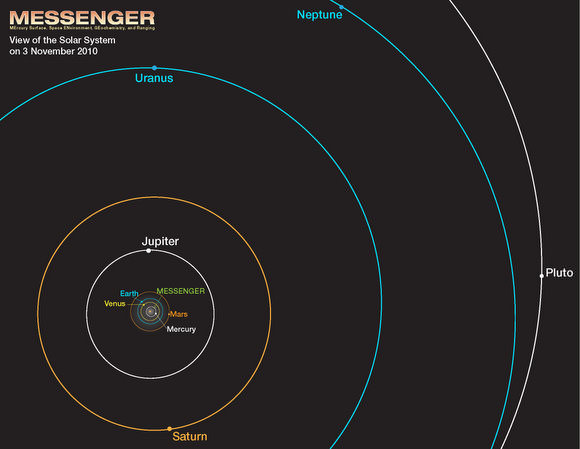[/caption]
Say cheese! The MESSENGER spacecraft has captured the first portrait of our Solar System from the inside looking out. The images, captured Nov. 3 and 16, 2010, were snapped with the Wide Angle Camera (WAC) and Narrow Angle Camera (NAC) of MESSENGER’s Mercury Dual Imaging System (MDIS).
All of the planets are visible except for Uranus and Neptune, which at distances of 3.0 and 4.4 billion kilometers were too faint to detect with even the longest camera exposure time of 10 seconds. Their positions are indicated. The dwarf-planet Pluto, smaller and farther away, would have been even more difficult to observe.
Earth’s Moon and Jupiter’s Galilean satellites (Callisto, Ganymede, Europa, and Io) can be seen in the NAC image insets. Our Solar System’s perch on a spiral arm provided a beautiful view of part of the Milky Way galaxy, bottom center.
The following is a graphic showing the positions of the planets when the graphic was acquired:
The new mosaic provides a complement to the Solar System portrait – that one from the outside looking in – taken by Voyager 1 in 1990.

“Obtaining this portrait was a terrific feat by the MESSENGER team,” says Sean Solomon, MESSENGER principal investigator and a researcher at the Carnegie Institution. “This snapshot of our neighborhood also reminds us that Earth is a member of a planetary family that was formed by common processes four and a half billion years ago. Our spacecraft is soon to orbit the innermost member of the family, one that holds many new answers to how Earth-like planets are assembled and evolve.”
Source: MESSENGER



Ack! I blinked at the wrong time. D’you think they’d mind taking it again?
Been waiting a LONG time for this image! If the Chinese have it right, as reported by the BBC, modern humans have been around for far longer than assumed…. how’s 100,000 years of waiting sound?
http://www.bbc.co.uk/news/science-environment-11618814
That is not the context, as I understand it. The clue in to laymen [disclaimer: despite being layman, I have a long standing interest in human evolution] is the end of the article discussing “controversy”.
Trinkaus is an old multiregionalist, which is a quickly dying subspecies of anthropologists. The old find of neanderthal and now denisovan genes in modern human populations rung the death bell for multiregionalism while slightly modifying main stream “out of Africa” models.
Due to the dynamics of the particular area of science, people invest their professional and sometimes private life in specific models, you will find a stream of these small “finds” (reinterpretations really) in the coming years trying to “save” multiregionalism. Especially from those who deals with bones instead of genomes.
You can find out about Trinkaus (and the other multiregionalists to be aware of) on Wikipedia. Also that modern humans are ~ 150 – 200 ky old: “Modern humans, Homo sapiens, evolved in Africa up to 200,000 years ago and reached the Near East around 125,000 years ago.” It is thus possible to find modern humans, if correct, in East Asia ~ 100 ka consistent with all the current evidence.
Though I believe the main stream idea so far is that the oldest Near East migration failed early. If that is untrue, and modern humans migrated and survived longer in East Asia, it would be interesting. Though presumably they couldn’t be the ones mixing with denisovans, and later with other modern humans to transfer the genes now seen associated with that region, I looked at the Denisovan paper again and the gene transfer times don’t fit, it is way too early. Maybe they survived to reenter the main population, maybe they regionally paved the way to live in the area, but they weren’t important outside of that.
Also, that they weren’t the ones mixing with denisovans is a fairly strong evidence against Trinkaus interpretation AFAIU. They would have been ideally situated to interact for a long time with more archaic H. sapiens (or whatever you deem neanderthal and denisovans to be). So I withhold my judgment, but not my breath.
“more archaic” Duh, now I’m going with the dumb terminology too. I mean other populations of H. sapiens (or whatever), of course.
where humans are?
Aliens are humans and human beings are aliens.
No. Human beings are animals, and animals are humans.
Real aliens would see the infestation of humankind and mercifully remove it — just like bunny rabbits being exposed to myxomatosis!
“There are some archaic features in the specimen and that suggests to us that these are not just simply modern humans coming out of Eastern Africa, but somewhere along the way they probably intermixed with regional groups of archaic humans,” Professor Trinkaus told BBC News.
Continue reading the main story
“Start Quote
There was something that allowed these modern humans to spread across southern Asia, but at the same time they weren’t able to spread further North across Asia or into Europe”
End Quote Erik Trinkaus Washington University, St Louis, US
“Previous evidence for co-existence was basically between Europe and Western Asia and adjacent part of Africa, but what this suggests is that the geographical range of co-existence spread all the way across Asia, which is an enormous difference.
“This is the first evidence for that.”
Oops… belongs under my previous entry. It IS a bit of a drift to say humankind has had to wait 100,000 years to see our solar system from this perspective but one could just as easily say millions of years?